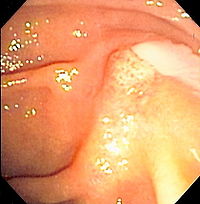
Photo from wikipedia
BackgroundMalignant obstructive jaundice is a common problem in the clinic. Currently, the generally applied treatment methods are percutaneous transhepatic biliary drainage (PTBD) and endoscopic biliary drainage (EBD). Nevertheless, there has… Click to show full abstract
BackgroundMalignant obstructive jaundice is a common problem in the clinic. Currently, the generally applied treatment methods are percutaneous transhepatic biliary drainage (PTBD) and endoscopic biliary drainage (EBD). Nevertheless, there has not been a uniform conclusion published on either efficacy of the two types of drainage or the incidence rate of complications. Therefore, we conducted a systematic review and meta-analysis of studies comparing endoscopic versus percutaneous biliary drainage in malignant obstructive jaundice, to determine whether there is any difference between percutaneous and endoscopic biliary drainage, with respect to efficacy and incidence rate of overall complications.MethodsThe enrolled studies contain a total of three randomized controlled trials and eleven retrospective studies, which together encompass 2246 patients with PTBD and 8100 patients with EBD.ResultsOur analysis indicates that there is no difference between PTBD and EBD with regard to therapeutic success rate (%), overall complication (%), intraperitoneal bile leak, 30-day mortality, sepsis, or duodenal perforation (%). Cholangitis and pancreatitis after PTBD were lower than after EBD, with odds ratios (OR) of 0.48 (95% confidence interval (CI), 0.31 to 0.74) and 0.16 (95% CI, 0.05 to 0.52), respectively. Incidences of bleeding and tube dislocation for PTBD were higher than EBD, OR of 1.81 (95% CI, 1.35 to 2.44) and 3.41 (95% CI, 1.10 to 10.60).ConclusionsThis meta-analysis indicates certain advantages for both PTBD and EBD. In the clinical practice, it is advised to choose specifically either PTBD or EBD, based on location of obstruction, purpose of drainage (as a preoperative procedure or a palliative treatment) and level of experience in biliary drainage at individual treatment centers.
Journal Title: Cancer Imaging
Year Published: 2017
Link to full text (if available)
Share on Social Media: Sign Up to like & get
recommendations!